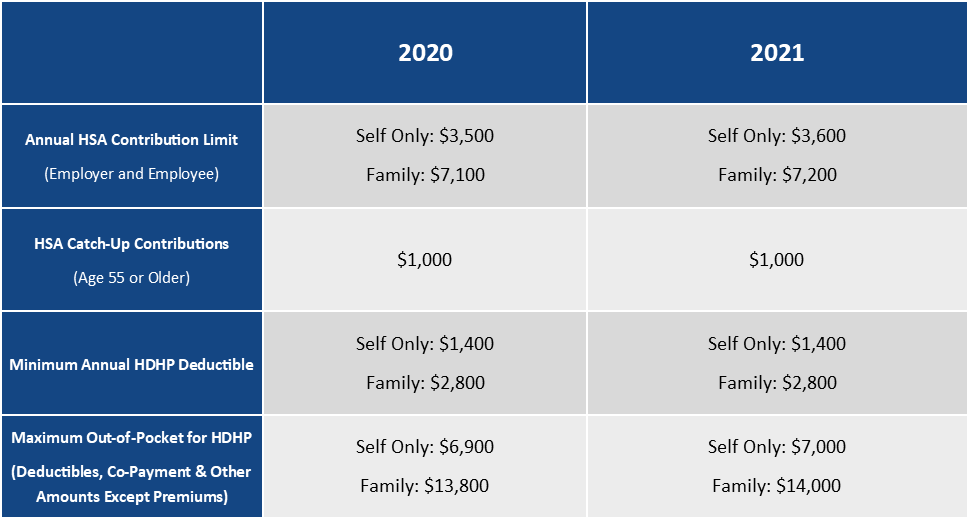What will 2021 bring us? After a year of turmoil and surprises, no one has a clear crystal ball. But there are some certainties, and one is that the federal government is changing a variety of numbers affecting the finances of businesses and individuals.

First, any individual or business that received government funds this year should keep that in mind and have records on hand. This includes unemployment benefits and Paycheck Protection Program funds. The taxable situation for these can be complicated, so be sure to discuss them with a financial professional before the end of the year.
Meanwhile, here are the big changes for 2021.
Affordable Care Act “affordability” percentage
Per IRS Revenue Procedure 2020-36, the ACA “affordability” percentage for 2021 is 9.83%, increasing slightly from 9.78% in 2020.
This means that, for 2021, employers subject to the ACA cannot charge employees more than 9.83% (of their household income) for the least-expensive self-only health insurance plan.
Employers may use one or more of these three IRS safe harbor methods to determine employees’ household income:
- The employee’s Form W-2 Box 1 wages.
- The employee’s hourly rate of pay multiplied by 130 hours, or the employee’s monthly salary.
- The federal poverty level for a household of one.
These safe harbors can be used only for the purpose of calculating ACA affordability.
ACA reporting
IRS Notice 2020-76 extends the deadline for employers to furnish ACA Form 1095-C or Form 1095-B to employees — it is changing from Jan. 31, 2021, to March 2, 2021. The notice also extends the IRS’ good-faith effort relief for plan year 2020 reporting.
Under the good-faith effort relief, employers will not be penalized for submitting incomplete or inaccurate ACA forms if they can “show that they made good-faith efforts to comply with the information-reporting requirements.”
The deadlines for filing Form 1095-C and Form 1095-B with the IRS remain the same: Feb. 28, if filing by paper, and March 31, if filing electronically.
Social Security wage base
The Social Security Administration announced that the Social Security taxable wage base for 2021 is $142,800, jumping from $137,700 in 2020. The employee’s and the employer’s Social Security tax rates remain at 6.2%.
The Medicare tax rate for 2021 is still 1.45% of all taxable wages, for both the employer and the employee.
Employees earning more than $200,000 for the year are still subject to an additional Medicare tax of 0.9%.
Health savings accounts and high-deductible health plans
 Data Source: IRS Revenue Procedure 2020-32
Data Source: IRS Revenue Procedure 2020-32
Health flexible spending accounts
This limit has not changed; $2,750 remains the limit for health care flexible spending accounts. However, the maximum carryover amount for 2021 has gone up to $550, an increase of $50.
Qualified commuter benefits
The contribution limit for pretax commuter benefits is $270 — the same as in 2020. This is the maximum pretax amount that employees can set aside to pay for public transportation, ridesharing, vanpooling and parking expenses.
401(k) contributions
Here are the 2021 contribution limits for 401(k) plans:
- Maximum employee contribution: unchanged at $19,500.
- Catch-up contribution for employees ages 50 and over: unchanged at $6,500.
- Maximum employee + employer contribution, excluding catch-up: $58,000.
Other inflation adjustments
The standard deduction for married couples filing jointly for tax year 2021 rises to $25,100, up $300 from 2020. For single taxpayers and married individuals filing separately, the standard deduction rises to $12,550 for 2021, up $150, and for heads of households, the standard deduction will be $18,800 for tax year 2021, up $150.
For tax year 2021, the tax brackets and their limits are as follows:
- 37% for incomes over $523,600 ($628,300 married filing jointly).
- 35% for incomes over $209,425 ($418,850 married filing jointly).
- 32% for incomes over $164,925 ($329,850 married filing jointly).
- 24% for incomes over $86,375 ($172,750 married filing jointly).
- 22% for incomes over $40,525 ($81,050 married filing jointly).
- 12% for incomes over $9,950 ($19,900 married filing jointly).
- 10% for incomes for incomes of $9,950 or less ($19,900 married filing jointly).
The bottom line? It’s been a complicated year. Touch base with financial professionals before the end of the year to make sure you’re on track for any adjustments.
Posted November 2020 – Copyright 2020
Disclaimers:
This information is offered with the understanding that Paytime, Inc. is not engaged in rendering legal, accounting, or other professional services. This information is meant to provide general and summary information only. The subject matter is not specific to any company, individual or industry and none should be implied. No attorney-client relationship or consultant-client relationship has been created and no legal or other professional advice is implied nor inferred. If legal, accounting, consulting or other professional advice is needed, those services should be acquired from a licensed professional. In no event will Paytime, its agents or employees be liable to you for anyone else for any decision made or action taken in reliance on this information.


